Nearly 40% of e-commerce sites suffer a traffic drop after replatforming, and most never see those visitors again.
When planning how not to lose traffic when migrating from Magento to Shopify, the real danger isn’t the move itself, it’s what gets overlooked in the process. From SEO gaps to broken links, even a small slip can cost thousands of clicks overnight.
In this article, we will explore:
- Follow this proven framework to preserve every visitor during your migration
- Leverage Shopify's built-in features to double your organic traffic
The 7-Step Blueprint to Migrate From Magento to Shopify Without Losing a Single Visitor
A well-planned Magento to Shopify migration can skyrocket your store’s performance, but without structure, it can also tank your traffic.
Here's a step-by-step, no-nonsense method to make sure you retain your hard-earned organic visibility throughout the migration process.
Step 1: Create Your URL Migration Blueprint (2-3 Weeks Before Launch)
Your migration's success hinges on meticulous URL planning. This critical foundation step ensures no high-value pages get lost in translation when switching platforms.
Key Actions:
- Export all Magento URLs using Screaming Frog or the Magento admin
- Catalog high-traffic pages with Google Analytics to identify the top 20% traffic-generating pages
- Document URL structure differences between Magento vs Shopify URL patterns
- Create a 1:1 URL mapping sheet matching every old URL to its new Shopify equivalent
- Prioritize by traffic volume, focusing on pages driving 80% of organic traffic
This comprehensive mapping becomes your migration roadmap. Without it, you're flying blind and risking significant traffic loss.

Pro Tip: Use Google Analytics' "Behavior > Site Content > All Pages" report to identify your most valuable URLs. Focus 80% of your mapping effort on the top 20% of pages.
Step 2: Set Up 301 Redirects Before Going Live
301 redirects are your traffic insurance policy; they tell search engines your content has permanently moved. Never launch without having every redirect tested and verified.
Implementation Steps:
- Bulk redirect implementation using CSV file import in Shopify admin (Content > URL Redirects)
- Individual redirect setup via Content > Menus > View URL Redirects > Create URL redirect
- Wildcard redirects for categories to handle product category URL changes systematically
- Shopify Plus advanced redirects using custom routing rules for complex scenarios
- Test every redirect using redirect checker tools before launch
Search engines treat 301 redirects as permanent moves, transferring approximately 90-95% of the original page's ranking power to the new URL.
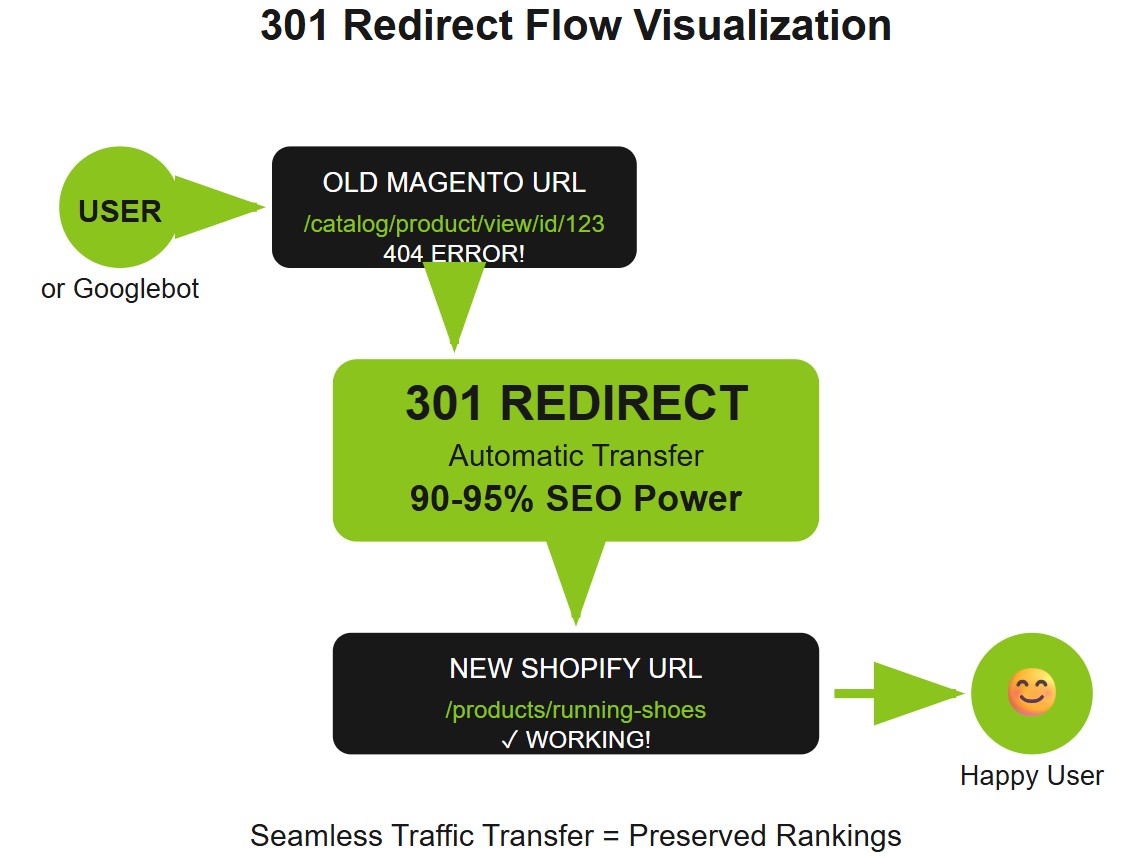
Pro Tip: Use tools like Redirect Path (Chrome extension) or Screaming Frog to bulk test redirects. A single broken redirect on a high-traffic page can cost you hundreds of visitors daily.
Step 3: Preserve All SEO Elements During Data Migration
Your SEO elements are the DNA of your search rankings; lose them, and you lose months of optimization work. This step ensures every piece of metadata transfers perfectly.
Critical Preservation Tasks:
- Meta titles and descriptions are manually transferred or script imported for all metadata
- Product image alt text, ensuring all image SEO attributes carry over
- Header tag structure maintaining H1, H2, H3 hierarchy with one H1 per page
- Product descriptions keep all SEO-optimized content intact
- Internal linking structure preserves link equity by maintaining relationships
Metadata is often overlooked during migrations, yet it's crucial for maintaining search visibility and click-through rates.
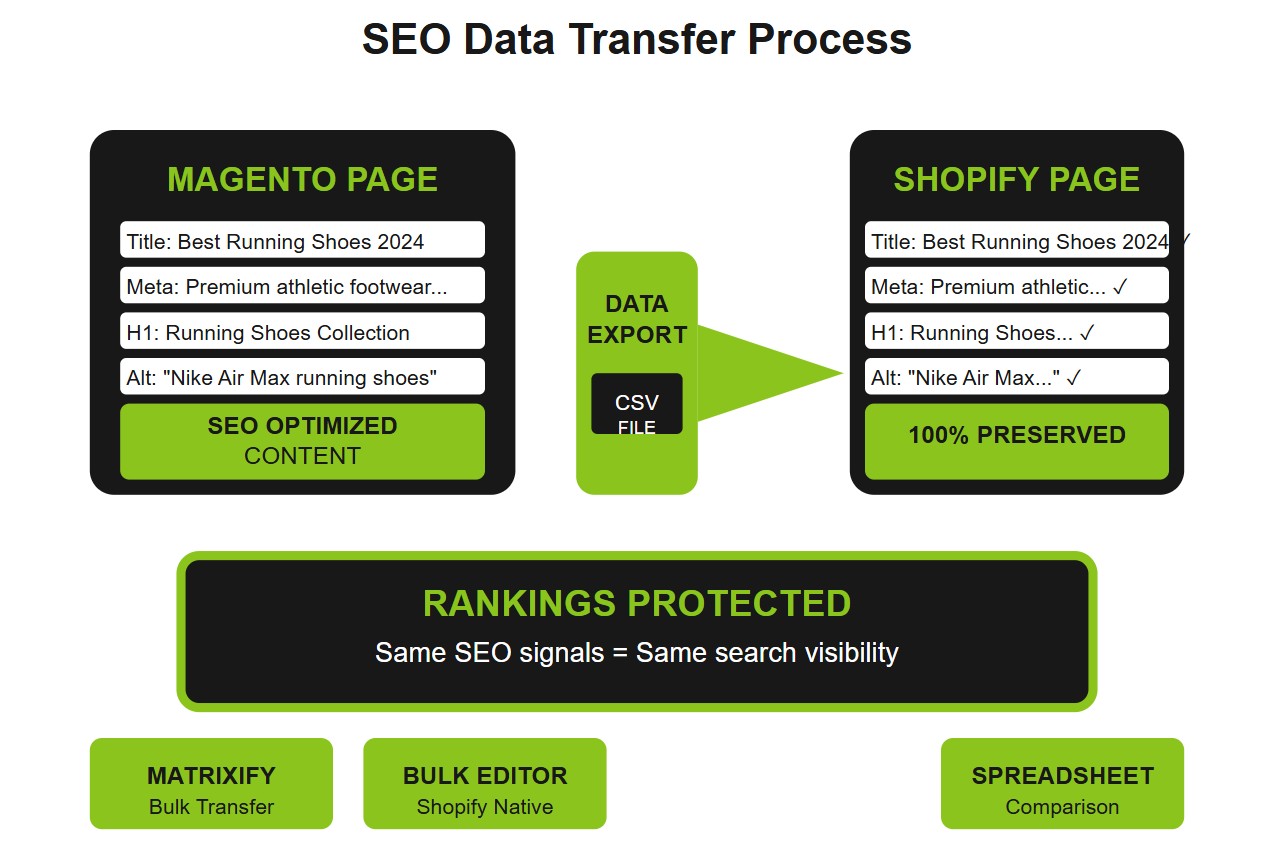
Pro Tip: Create a spreadsheet comparing old vs new metadata. Use Shopify's bulk editor or Matrixify to import metadata efficiently rather than manual entry.
Step 4: Implement Pre-Launch SEO Verification
Never go live without comprehensive testing; this verification phase catches issues before they impact real traffic. Your staging environment serves as a safe testing ground.
Verification Checklist:
- Staging site setup testing everything on staging.yourstore.myshopify.com
- Crawl staging site using Screaming Frog to verify redirects and metadata
- Check Search Console setup, adding and verifying the new domain
- Sitemap verification confirming Shopify auto-generated sitemap at yourstore.com/sitemap.xml
- Analytics code installation, setting up Google Analytics with proper goal tracking
This testing phase prevents costly mistakes that could take weeks to recover from. Catching errors now saves you from scrambling while losing traffic.
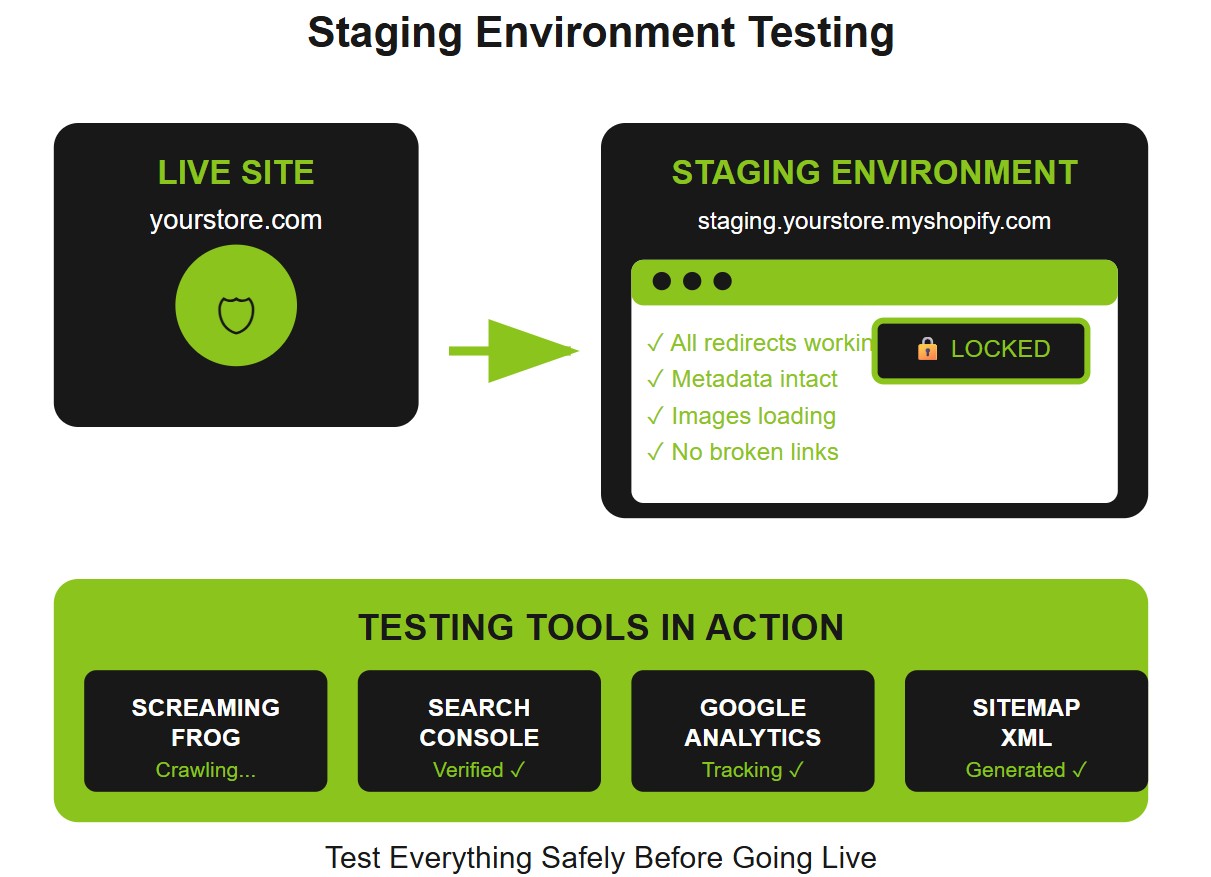
Pro Tip: Password-protect your staging site and use the "noindex" meta tag to prevent accidental indexing by search engines.
Step 5: Execute the Migration With Zero Downtime
Migration day is game day; every minute of downtime potentially costs sales. Strategic timing and real-time monitoring ensure a smooth transition.
Execution Protocol:
- DNS change timing is scheduled during low-traffic hours (typically 2-4 AM)
- Monitor redirect status using tools like Link Monitor or Easy Redirects apps
- Real-time traffic monitoring, watching Google Analytics for immediate drops
- 404 error tracking, setting up custom Google Analytics reports
- Search Console monitoring, checking for crawl errors and indexing issues
The goal is invisible migration - customers should notice improved performance, not disruption.
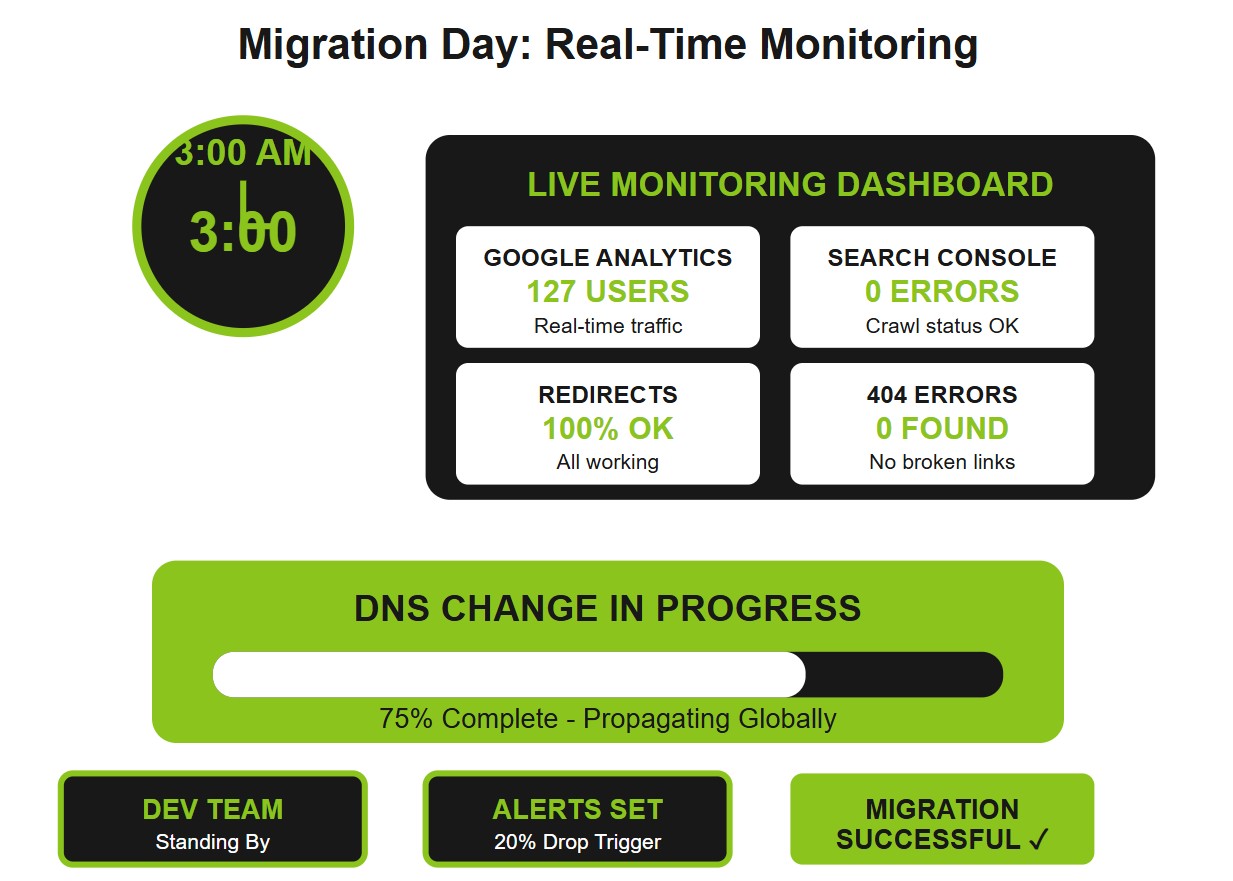
Pro Tip: Have your development team on standby. Set up alerts for traffic drops exceeding 20% and have a rollback plan ready.
Step 6: Post-Migration Traffic Recovery Protocol (First 72 Hours)
The first 72 hours determine your migration's success or failure. This critical period requires intensive monitoring and rapid response to any issues.
Recovery Actions:
- Submit sitemap to Search Console, forcing Google to recrawl your new structure
- Check all priority redirects, testing your top 50 traffic-driving URLs manually
- Monitor Core Web Vitals, ensuring page speed hasn't degraded using PageSpeed Insights
- Track keyword rankings using Ahrefs or SEMrush to monitor position changes
- Fix broken internal links, updating any links still pointing to old URLs
Search engines need time to understand your new structure. Proactive communication accelerates this process.
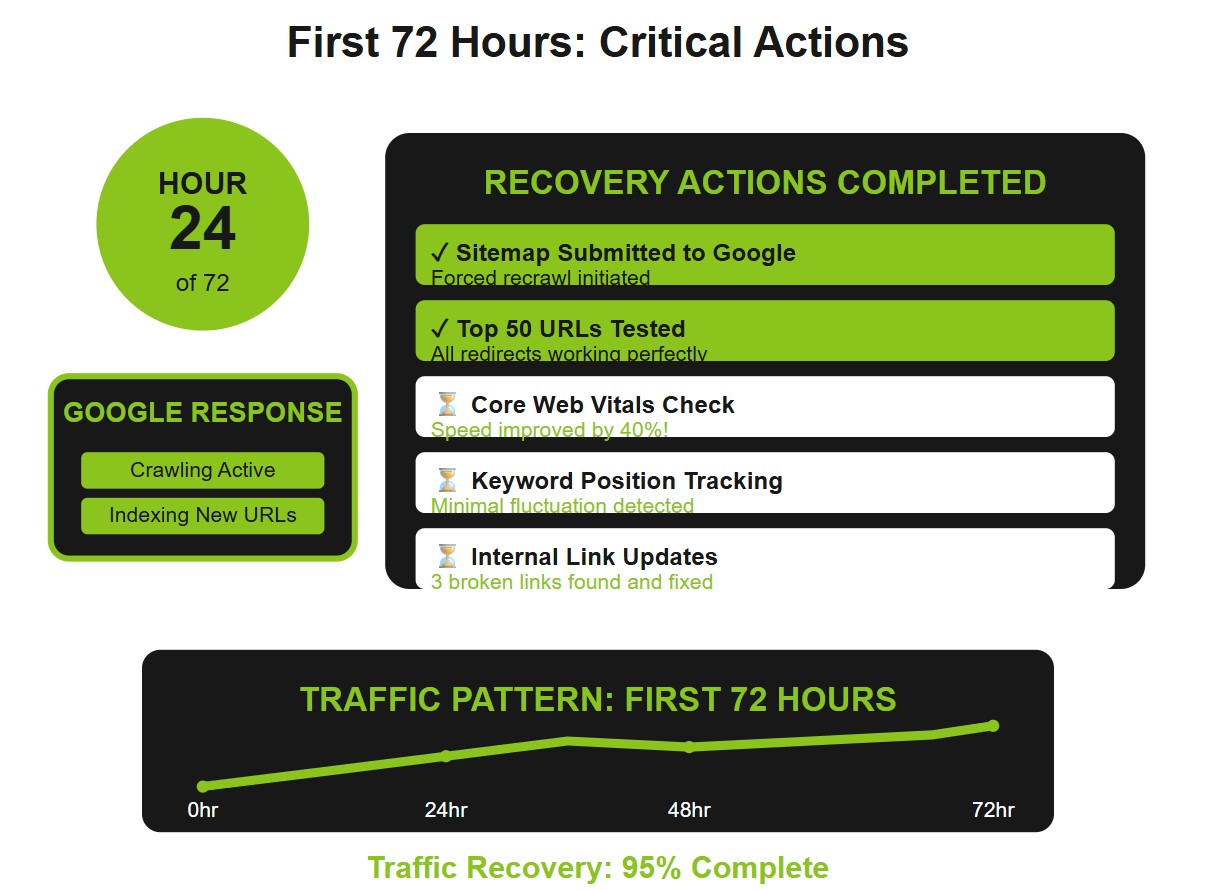
Pro Tip: Create a priority URL list of your top 50 pages and check them hourly for the first 24 hours. Monitor real-time traffic patterns constantly.
Step 7: Week 1-4 Optimization and Recovery
Your migration isn't complete until traffic fully recovers. This phase focuses on fine-tuning performance and leveraging Shopify's advantages to exceed previous traffic levels.
Optimization Tasks:
- Daily traffic monitoring comparing organic traffic to the pre-migration baseline
- Redirect chain elimination, finding and fixing chains using Ahrefs site audit
- Content optimization, enhancing product pages with Shopify's SEO features
- Search Console annotation marking migration date in Google Analytics
- Performance optimization, optimizing images, and leveraging Shopify's CDN
Superior performance infrastructure and SEO capabilities often result in better rankings within 4-8 weeks.
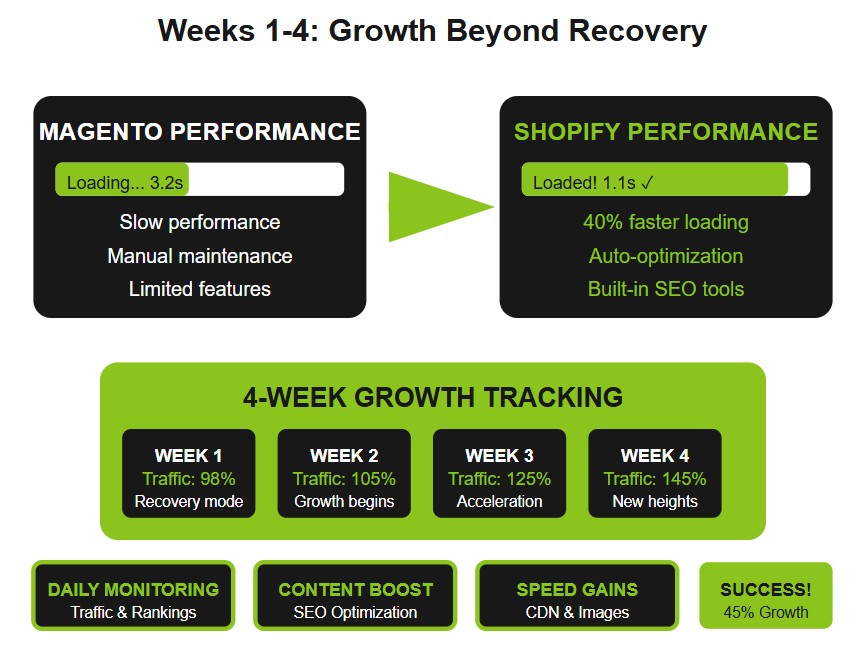
Pro Tip: Document everything in a migration log. Track daily organic traffic, keyword positions, and issues. This data proves ROI to stakeholders.
A smooth migration isn’t just technical, it’s strategic. Prioritize planning, precision, and post-launch agility to come out stronger than before.
Unlock Explosive Traffic Growth: Your Shopify Advantage Playbook
Your migration is complete, traffic is preserved - now it's time to turn Shopify into your growth engine. While Magento requires constant technical maintenance, Shopify frees you to focus on what matters: scaling your traffic and revenue.
Here's how to leverage Shopify's unique advantages to achieve traffic growth that would have been impossible on your old platform.
Exploit Shopify's Built-in SEO Superpowers
Shopify isn't just faster than Magento, it's SEO-optimized by design. Every feature is built with search engines in mind, giving you competitive advantages that compound over time.
Core SEO Advantages to Leverage:
- Automatic schema markup for rich snippets without coding
- Mobile-first indexing optimization with responsive themes by default
- Clean URL structures that search engines love (/products/product-name)
- Automatic sitemap generation and submission capabilities
- Built-in SSL certificates and security headers for ranking boosts
Your Shopify store automatically handles technical SEO tasks that require developer intervention on Magento. This means more time for content creation and strategic optimization instead of fixing technical issues.
Pro Tip: Install Shopify's SEO Manager app to identify quick wins. It automatically audits your site and provides actionable recommendations that can boost rankings within weeks.
Harness the Traffic-Driving App Ecosystem
Shopify's 8,000+ app ecosystem, paired with the right eCommerce services, is your secret weapon for traffic growth. Unlike Magento's complex extensions, Shopify apps install in minutes and integrate seamlessly.
High-Impact Traffic Growth Apps:
- SEO apps: Plug in SEO, TinyIMG, or Smart SEO for advanced optimization
- Content marketing: Bloggle, GemPages, or Shogun for high-converting content
- Social proof: Loox, Judge.me, or Yotpo for review-driven traffic
- Email capture: Privy, OptinMonster, or Justuno for list building
- Speed optimization: TinyIMG, SearchPie, or Booster for performance gains
Each app adds functionality that would require custom development on Magento. The result? Faster implementation of growth strategies and more time testing what works.
Pro Tip: Start with 3-5 essential apps, measure their impact for 30 days, then gradually add more. Too many apps can slow down your site and hurt the performance gains you've achieved.
Capitalize on Performance Improvements for Ranking Boosts
Page speed is a direct ranking factor, and Shopify's infrastructure gives you automatic advantages over most Magento setups. But you can push these gains even further.
Performance Optimization Strategies:
- Image optimization: Use Shopify's automatic WebP conversion and lazy loading
- CDN leverage: Shopify's global CDN reduces loading times worldwide
- Code efficiency: Liquid templating is lighter than Magento's PHP complexity
- Caching optimization: Built-in edge caching without server management
- Third-party script management: Control what loads when for optimal speed
Google's Core Web Vitals directly impact rankings, and Shopify stores typically score 40-60% better than equivalent Magento sites. This translates to measurable ranking improvements within 2-3 months.
Pro Tip: Use Google PageSpeed Insights weekly to monitor your scores. Aim for 90+ on mobile and desktop, Shopify's infrastructure makes this achievable without technical expertise.
Dominate Mobile Search with Mobile-First Design
Over 60% of e-commerce traffic comes from mobile devices, and Shopify's mobile optimization gives you a significant competitive edge over slower, less mobile-friendly Magento stores.
Mobile Traffic Growth Tactics:
- Responsive themes: All Shopify themes are mobile-optimized by default
- Touch-friendly navigation: Optimized for mobile user behavior
- Fast mobile checkout: Shopify's checkout converts 35% better on mobile
- Accelerated Mobile Pages (AMP): Available through apps for ultra-fast loading
- Mobile-specific features: One-tap payments, mobile-optimized search
Mobile page speed improvements can increase mobile traffic by 25-50% as Google prioritizes fast-loading sites in mobile search results.
Pro Tip: Test your mobile experience weekly using Google's Mobile-Friendly Test tool. Small improvements in mobile usability can lead to significant ranking and traffic gains.
Scale Globally with International Expansion Features
Shopify's international capabilities unlock traffic from global markets that were difficult to target effectively on Magento without complex multi-store setups.
International Growth Opportunities:
- Multi-currency support: Display prices in local currencies automatically
- Shopify Markets: Manage multiple countries from one dashboard
- Localization features: Translate content and customize by region
- International SEO: Hreflang tags and country-specific optimization
- Global shipping: Built-in shipping calculators for worldwide delivery
International traffic can account for 30-70% of total traffic for e-commerce stores, and Shopify makes global expansion 10x easier than managing multiple Magento installations.
Pro Tip: Start with English-speaking markets (UK, Australia, Canada) for easier expansion, then gradually add European and Asian markets based on your analytics data.
Implement Advanced Content Marketing Strategies
Shopify's blogging and content features surpass Magento's basic blog functionality, enabling sophisticated content marketing that drives organic traffic growth.
Content-Driven Traffic Growth:
- Advanced blog features: Rich text editing, SEO optimization, and social sharing
- Landing page builders: Create high-converting pages without coding
- Product content optimization: Enhanced product descriptions and galleries
- User-generated content: Integrate customer reviews and photos seamlessly
- Video content integration: Embed product videos and tutorials easily
Content marketing can drive 3x more traffic than paid advertising when executed properly, and Shopify's tools make content creation and optimization significantly easier.
Pro Tip: Create weekly blog content targeting long-tail keywords related to your products. Use Shopify's built-in analytics to identify which content drives the most traffic and conversions.
Measure and Scale Your Growth
Data-driven optimization is key to sustainable traffic growth. Shopify's analytics and integration capabilities provide deeper insights than Magento's basic reporting.
Growth Measurement Framework:
- Shopify Analytics: Built-in traffic, conversion, and revenue tracking
- Google Analytics 4: Enhanced e-commerce tracking and attribution
- Search Console integration: Monitor organic search performance
- App-specific analytics: Track performance of individual growth strategies
- A/B testing tools: Test and optimize continuously for better results
Monthly traffic growth of 10-25% is achievable with consistent optimization and the right strategy mix.
Pro Tip: Set up automated reports that track your key metrics weekly. Focus on organic traffic growth, conversion rate improvements, and revenue per visitor - these metrics indicate healthy, sustainable growth.
Your migration to Shopify isn't just about preserving traffic; it's about unlocking growth potential that was impossible on Magento. With the right strategy, your best traffic days are ahead of you.
Turn Migration Into Momentum, Not a Setback
Migrating from Magento to Shopify isn’t just about survival; it’s your chance to level up. By following a structured SEO-first approach, preserving critical elements like URLs, redirects, and metadata, and then harnessing Shopify’s built-in advantages, you don’t just protect traffic, you set the stage for scalable growth.
Avoid costly mistakes, act intentionally, and let this migration be the springboard to stronger rankings, faster performance, and higher conversions.







%20(1).jpg)

.jpg)
%20(1).jpg)

